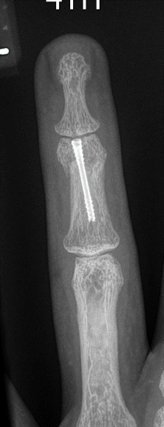MEET THE SURGEON

Dr. Bryan D. Brown, MD
- Assistant Program Director, Orlando Health Orthopedic Residency
- Orthopedic Hand, Elbow & Shoulder Surgeon
- Orlando Health Jewett Orthopedic Institute
OVERVIEW
A 66-year-old female sustained a displaced, intra-articular proximal phalanx base fracture of the right hand following a ground-level fall while jogging. Dr. Brown successfully performed percutaneous intramedullary fixation using the NX Nail, opting for this technique due to its ability to provide rigid internal stability without the compressive forces that could exacerbate the comminuted fracture. The minimally invasive procedure allowed for early mobilization, and the patient began a tendon-gliding exercise program immediately postoperatively. At the two-week follow-up, X-rays confirmed excellent fracture alignment, and the patient exhibited significantly improved range of motion.
CASE INTRODUCTION
A 66-year-old female presented to Dr. Bryan D. Brown’s clinic following a ground-level fall while jogging. The patient reported immediate pain and deformity of the small finger, which was significantly bruised and angulated upon physical examination. The patient displayed limited active range of motion, with gross abnormality to the digit.
Radiographs confirmed a displaced, intra-articular fracture of the proximal phalanx base. Given the patient's active lifestyle and desire to return to her regular daily activities as quickly as possible, a plan for surgical intervention was discussed. After considering various treatment options, the patient elected to proceed with percutaneous intramedullary fixation using the NX Nail.
Below: Pre-Operative Imaging

PRE-OPERATIVE PLAN
This particular fracture, located at the base of the proximal phalanx, was deemed highly unstable, making conservative options such as reduction and splinting less favorable. Intramedullary fixation using the NX Nail offered several advantages over traditional k-wire or plating options, including rigid internal stability without compressive forces that could potentially harm the comminuted and oblique fracture. Intramedullary fixation using the NX Nail also allows for minimal soft tissue disruption, to assist in a fast return to work-related activities.1
INTRAOPERATIVE DETAILS
The surgery was performed using standard hand surgery positioning, with the patient placed supine and the hand positioned over a bump for optimal access. Reduction was achieved by applying longitudinal traction to the affected digit while flexing the metacarpophalangeal (MCP) joint over a towel bump to aid in proper alignment.
Two 0.8mm K-wires were inserted antegrade through the collateral recesses at the base of the proximal phalanx, minimizing articular penetration. Intraoperative fluoroscopy confirmed the fracture reduction and proper K-wire placement.
A small stab incision was made over each wire, followed by blunt dissection to expose the proximal phalanx bone. To minimize the risk of damaging the proximal interphalangeal joint (PIPJ) cartilage, Dr. Brown accessed the proximal phalanx through the collateral recesses. A depth gauge confirmed that a 2.0mm x 14mm and 2.0mm x 24mm NX Nail were the appropriate sizes for the patient’s intramedullary canal. Dr. Brown opted for two nails to ensure optimal rotational control of the finger, resulting in a “Y” construct. The 1.5mm cannulated drill bit was passed over the K-wire, followed by a countersink drill for the near cortex. This preparation allowed the NX Nail to ensure secure fixation.
Once the NX Nails were inserted, the fracture was reassessed under fluoroscopy. The finger was cycled through a full range of motion to confirm stability and correction of the preoperative deformity. The two stab incisions were closed with a single 4-0 chromic suture, and the small and ring fingers were buddy-taped together with soft dressings. No additional splinting or immobilization was required.
Below: Intra-Operative Imaging

POSTOPERATIVE CARE
The patient was started on a full active range of motion immediately postoperatively, with a tendon-gliding home exercise program. No splinting was necessary, as the NX Nail provided sufficient stability for early mobilization. The patient will continue to follow up for further evaluation, but at her two-week follow-up, her range of motion was improving, and X-rays confirmed that the fracture alignment remained excellent.
Below: Post Operative Imaging (Two weeks)

CONCLUSION
In this case, the NX Nail was able to effectively treat a complex intra-articular fracture of the proximal phalanx. The nail provided rigid stability while preserving soft tissue integrity, allowing the patient to return to early mobilization and her daily activities with minimal complications.
References
1. Chao J, Patel A, Shah A. Intramedullary screw fixation comprehensive technique guide for metacarpal and phalanx fractures: pearls and pitfalls. Plast Reconstr Surgery–Global Open. 2021;9(10):e3895.
Product Resources
Field Orthopaedics. (2024). NX Nail Phalanx Long Surgical Technique. Brisbane, Australia: Field Orthopaedics.
FO-010272-MM Version 1 Nov 2024




